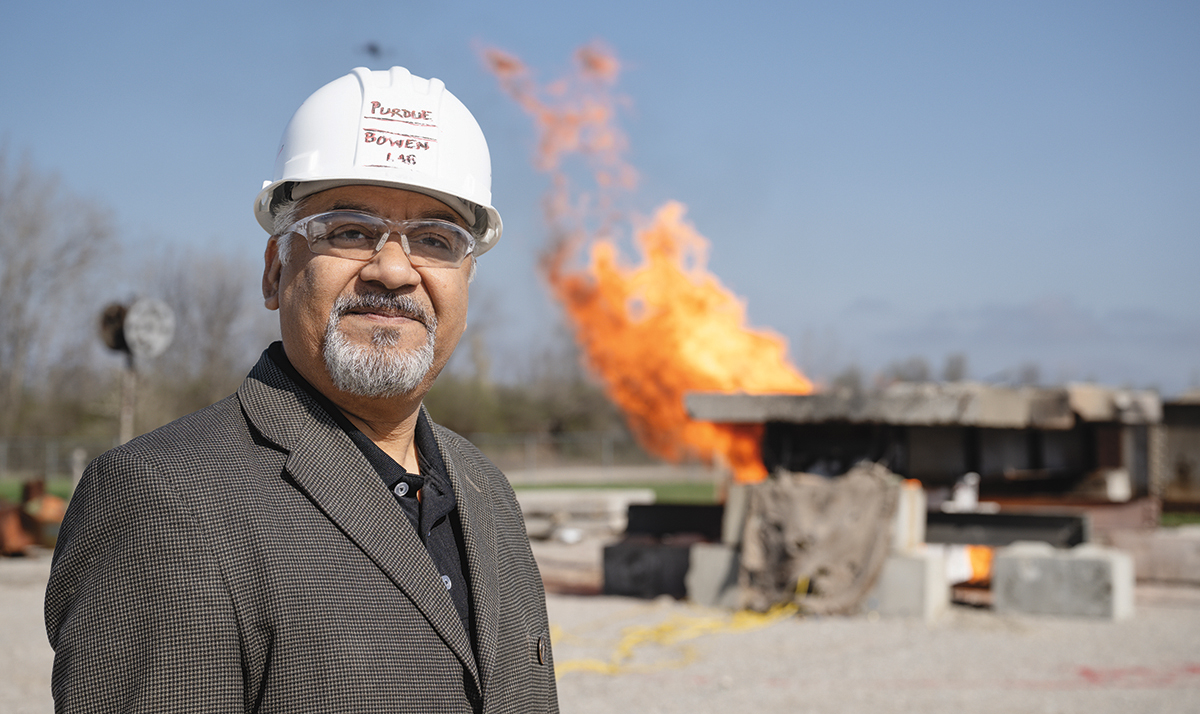Cool Factor
Cool Factor

Novel fire tests could change how crews save burning bridges
Hundreds of steel bridge fires occur in the U.S. each year. When the fire department arrives on the scene, its first priority is safely evacuating the area while putting out the fire. But after the flames have been doused, what’s the best method of cooling the steel with limited damage to the structure?
A research team led by Amit Varma, the Karl H. Kettelhut Professor of Civil Engineering and director of the Bowen Laboratory of Large-Scale Civil Engineering Research, is testing cooling methods to determine the best process to preserve the integrity of a steel bridge following a fire.
The project, titled Steel Bridge Inspection, Assessment, Repair and Management under FIRE, is funded by the Indiana Department of Transportation under the Joint Transportation Research Program. Engineers from INDOT were on hand to observe an experiment at the Steel Bridge Research Inspection Training and Engineering Center (S-BRITE) in April. Michael Ubelhor, secretary of transportation and infrastructure for the state of Indiana, was also present.
Tom Bradt, lead research engineer at Bowen and a volunteer firefighter, led the collaboration with Ron Huffman, an outside consultant, to design custom fire testing equipment that could ignite six propane burners to simulate the intensity of a fire caused by the collision of a gasoline fuel tanker.
“Gasoline tankers have thousands of gallons of fuel aboard,” said Shivam Sharma (MSCE ’22), a graduate research assistant in civil engineering and lead researcher on the project. “When there’s a lot of fuel, the fire will burn very hot, rapidly increasing the temperature of the steel. Overheating changes the mechanical properties of the metal, causing it to soften and become more ductile. Then, if heated steel is cooled too quickly, it can become harder and more brittle.”
This was the second steel bridge fire test executed during the spring semester with each using different firefighting techniques. In February, the steel was allowed to cool naturally through air exposure, after the base fire was extinguished. In April, a crew from the Purdue Fire Department was on hand to blast the bridge with water hoses.
“We’re still in the nascent stages of evaluation, but once we’ve analyzed the measurements and data, that information will be used to establish guidelines for fire departments responding to steel bridge fires.”

Sharma led the team in designing the test setup, instrumenting the girders, fabricating the assembly, conducting the test, developing safety protocols and performing numerical studies and material testing. He also spearheaded the microscopic analysis of the steel’s microstructure to identify changes that affect its mechanical properties before and after testing.
For both tests, the fire burned for 30 minutes before it was turned off. Early results indicated that the steel reached temperatures high enough to cause degradation in properties within 10 minutes. Microstructure examinations showed that cooling the bridge with water versus air resulted in slightly different post-fire microstructure of the steel. Another significant finding was the large deflections observed during the tests, which exceeded the predictions of the team’s numerical models.
“Estimating structural response under fire is very complex,” Varma said. “Physical studies of this magnitude have not been completed before because it’s a dangerous experiment that requires a comprehensive safety plan, extensive planning and coordination, and the right set of circumstances. It’s the type of experiment that could only be conducted at Purdue.”
Although Varma has previously conducted reconnaissance on steel bridge fires, the opportunity to stage a controlled experiment to obtain active measurements is invaluable. The potential impact of the research will inform not only fire crews’ responses, but also bridge inspectors’ decisions on whether the bridge can be reopened, and how soon after the fire.
“When a bridge is closed to traffic for any reason, every minute matters,” Varma said. “A closed bridge can disrupt supply chains, affect traffic patterns, alter access to health care and have a ripple effect through the economy. As inconvenient as bridge closure can be, the priority is always safety.”
For Varma, this experiment is the culmination of decades of research on fire behavior, analysis and design of structures. The opportunity to mentor Sharma — someone who is just embarking on a career — on a project of this caliber is equally rewarding.
“Working on a project of this magnitude sets the tone for the rest of his career,” Varma said. “I expect him to go on and design even more complex experiments and complete them successfully. I expect great things from him.”
